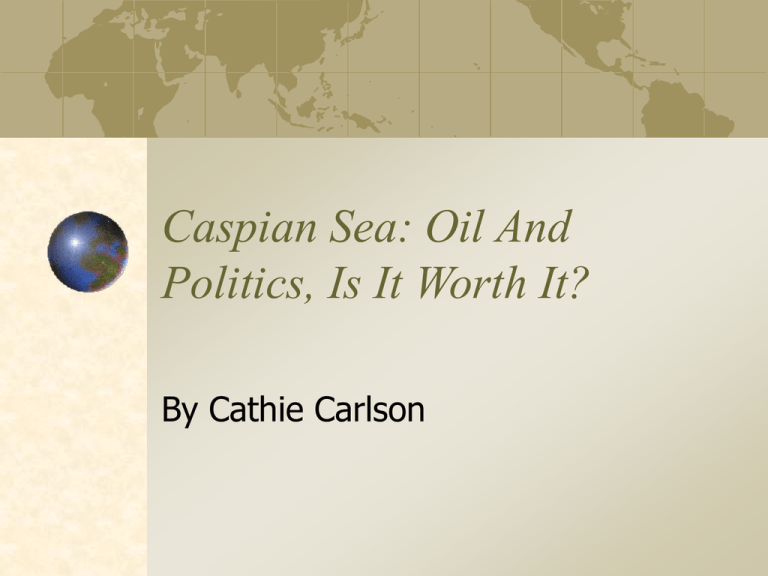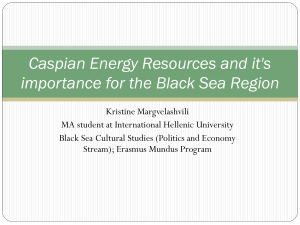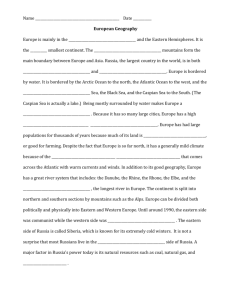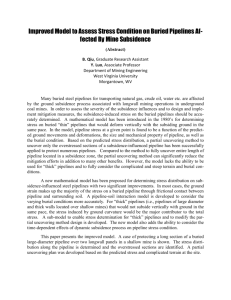Caspian Sea: Oil And Politics, Is It Worth It?
advertisement

Caspian Sea: Oil And Politics, Is It Worth It? By Cathie Carlson Can the Caspian Sea Be Our Savior? The Caspian sea is an untouched region of potentially big oil resources. The newness of this region could alleviate problems that would result from a cutoff of 25% of oil imported to the U.S. thereby giving the U.S. a respite in its oil imports while it tries to create a less oil dependent nation. The Oil problem will get worse before it gets better Problems with the Caspian Sea area: Geopolitics Pipelines Oil dependence from other countries The lack of desire on the part of Americans to look for alternative means Geopolitics and Pipelines Five countries border the Caspian sea and each have their own agendas regarding the politics in the region Each of the five countries as well as their neighbors and other countries have their own agendas especially when it comes to the pipelines Russia Kazakhstan Turkmenistan Iran Azerbaijan The players include: The Five Caspian Sea Neighbors The United States China Turkey Other Regional Neighbors like Pakistan, Afghanistan, and India The Oil Companies Oil Dependence from other countries It’s not just the United States who is seeking more and more oil to meet its needs Other countries, especially Asian countries, are going to have additional oil needs in the coming decades China and India with their large populations are going to exceed the U.S. demands for oil in the coming years Lack of desire to shift to new resources Americans equate cars and driving with freedom and oil is needed to drive cars Americans demand less dependence on Mid East oil but are not as willing to alter their daily habits What the Caspian Sea Oil Provides Benefits via the Caspian sea: Provides a safety net while other energy alternatives are being researched and developed The U.S. would be less dependent on the Middle East and the fragile political structures that control that region’s oil The Geopolitical and Pipeline Concerns The Caspian Sea Facts and Figures: The Caspian Sea is 700 Miles Long It contains an estimated 200 billion barrels of oil and up to 300 trillion cubic feet (Tcf) of natural gas Much of the area remains unexplored and unexploited Five countries border the sea The sea is actually a lake as it has no ocean outlet Disputes over control of the resources and boundary issues exist The Caspian Sea Problems: There are only estimates as to the reserves; no one really knows how much oil exists Political instability exists in the region Pipeline security is questionable Pipelines to get the oil out have become a political issue China and the United States have their own agendas as to who should get the oil and where the pipelines should go 1. Russia Russia has the most influence in the region The Soviet Union controlled most of the region and only had to share a border with Iran. Now four of the current countries surrounding the Sea were once part of the Soviet Union Countries like Turkmenistan and Azerbaijan are heavily dependent upon Russia Russia controls the only current pipeline from the Caspian Sea Russia Wants to Maintain its Influence Russia has maintained pipeline supremacy in the region “Since 1991, Russia has made a concerted effort to ensure that existing pipelines continue routing through Russia, and it has largely succeeded.” All current pipelines pass through Russia • The pipeline from Baku and the pipeline from Kazakhstan have all been routed to Russian oil terminals in the Black Sea • Russia has maintained this supremacy by encouraging countries to take advantage of the current system rather than investing in a new pipeline system 2. Iran Iran could be a key player Where Iran once bordered only the Soviet Union, it now shares its borders with three newly created states, two of which border the Caspian Sea – Azerbaijan, Turkmenistan Iran is the only country bordering the Caspian Sea to be a member of OPEC “Axis of Evil” – The U.S. v Iran Since the 1979 hostage crisis in Tehran, the U.S. has labeled Iran a terrorist state, a label which was repeated in the 2002 State of the Union address The U.S. vigorously opposes any contact with Iran The U.S. has imposed sanctions against Iran and U.S. companies are prohibited from accessing any oil or investing in any oil fields in Iran The U.S. discourages the laying of oil and gas pipelines through Iran 3. Kazakhstan Potential Oil Giant Kazakhstan boasts the third largest deposits in the world after the Middle East and Russia There are 10bn-17illion barrels of proven oil reserves and some estimates claim there are about another 70 billion barrels worth of oil Three quarters of the Caspian Sea lies under the Kazak sector With Existing Pipelines An existing pipeline from Kazakhstan through Russia’s Black Sea port makes this country one of the most stable in the region Kazakhstan is landlocked and must rely on pipelines to get its oil and gas out of the country And Heavy Ties With Russia The only existing pipelines for oil and gas are Russia pipelines that go through Russian terminals thus making Kazakhstan and the other countries heavily dependent on Russia And Heavy Ties With Russia Russia and Kazakhstan share a border and share the boundaries for their oil and gas fields in the Caspian Sea which only increases the ties between the two countries Kazakhstan signed a collective security agreement after it gained its independence but recently refused to increase military cooperation with Russia 4. Turkmenistan Future Uncertain The U.S. Department of Energy estimates Turkmenistan’s proven oil reserves at 546 million barrels More than 20% of its reserves are under production The country’s oil output remains a fraction of what it was during the Soviet era Oil refining will become a larger sector of its economy than oil production Pipelines Critical Today, Turkmenistan relies almost exclusively on Russia’s pipeline network for its oil and gas exports A more convenient line through Iran has been proposed This line would only require 100km of pipes to link Turkmenistan to Iran’s pipeline network 5. Azerbaijan Russia, Iran and the U.S. Russia As a former Soviet state, Azerbaijan has many links with Russia These links include one of the new pipelines Russia built that goes from Baku through Russian terminals to the Black Sea Iran Only 100 kilometers of pipeline would be needed to link Azerbaijan to Iran’s pipeline networks to the Persian Gulf Iran would prefer to import oil for its northern regions (supplied by Azerbaijan) so it could free up its southern oil fields for export via the Persian Gulf The United States Azerbaijan does not currently supply oil to Iran, instead it sends its oil through pipelines from Turkey to the Mediterranean Sea The Baku-Ceyhan pipeline is favored by the United States • This pipeline would run from Baku to the Turkish Mediterranean port of Ceyhan • As a result of the September 11th attacks, this proposal has been give new life and construction of the almost $3 billion pipeline may begin soon Pipeline Turmoil: Geography, Politics and More Why are pipelines such a big deal? “In landlocked central Asia there is no point in pumping oil and gas if you cannot get it to market. All the pipelines in the area run over Russian soil and, until now, the Kremlin has been playing hardball limiting the access to pipelines and charging usurious tariffs.” Which Way to Go? There are four pipeline options North-Northwest Westbound Eastbound Southbound Pipelines in the Region North-Northwest: Linking pipelines to Russia’s existing system Pro Russia has an existing system This is the easiest option and the fastest way to to transport oil and gas out of the region Con It’s system is complex and poorly maintained The countries who have used this system resent Russia’s control of the export market and hard currency Many of the countries would prefer to bypass Russia altogether Russia’s Pipelines Westbound: Baku-Ceyhan Pro Most favored option by the U.S. Con Expensive Target is primarily Europe and companies are wary of investing in a mature market with limited growth Eastbound : Long-distance pipelines used to transport oil to China and eventually Asia-Pacific Pro An 1,800 mile proposed pipeline from Kazakhstan and a 4,200 mile proposed pipeline from Turkmenistan to China would be the most direct way to link Central Asia and the Far East Con This is the most expensive and geographically difficult alternative Southbound: Two pipelines – one to Iran and another to Pakistan and India though Afghanistan Pro Pipeline through Iran is the most economical of all options Pipeline to India would ease burden on that energy hungry country Con The U.S. opposes any pipeline through Iran and therefore few investors have been attracted India wants to bypass Pakistan completely The Other Players: The U.S., China, and the Oil Companies The United States The United States is trying to create ties with some of the former Soviet countries in order to contain Russian dominance in the region Ironically, the U.S. presence in the region due to September 11, has eased some of the pressure to follow Russia’s lead by some of the Caspian states The United States, ctd. U.S. presence has been seen by some to provide an excuse to side with the U.S. Unfortunately, the U.S. policies against Iran have locked U.S. companies from that market. An Iranian pipeline would only harm the companies even more China China will increasingly be searching for oil The Asia-Pacific region as a whole is dependent on Middle East oil More than 90% of the region’s oil comes from the Middle East as opposed to 25% of the United States’ oil China, ctd Kazakhstan as China’s neighbor and as the nation most dependent on a foreign country’s pipeline is just as likely to look East as to look West to sell its oil The Oil Companies All the large oil companies have expressed interest in investing in the region The oil companies are expected to invest the billions of dollars to create and maintain the needed pipelines Politics have added difficulties to the investment possibilities in the regions ExxonMobil Sites The Oil Companies, ctd. U.S. oil companies are prohibited from investing with Iran But other companies are not Political instability in the region makes companies hesitant to invest Fear of MidEast like problems compound the region’s image as unstable Pipeline Security The present and future pipelines will cross many borders The issue is who will protect the pipelines and who will pay for the security Legal Issues The Status of the Caspian Sea: Is it a Lake or a Sea If it is a sea then the three mile limit of the territorial waters applies Boundary disputes are an issue between many of the countries in the region Legal Issues - What can be done? Regional discussions and treaties are the best means of solving the boundary disputes Contracts between oil companies and the countries need to address issues of infrastructure, pipeline security and pipeline transportation Legal Issues – What Can be Done? The United States needs to eliminate the barriers it has imposed on U.S. oil companies in order to prevent investment in Iranian oil. This would involve Congress as well as the President. Summary The Caspian Sea is filled with possibilities but two big problems stand in its way to becoming the savior to US dependence on Mideast oil Pipelines need to be built Politics affect everything in the region and at this time hampers a productive solution to the pipeline problem Summary, ctd. The U.S. and China seem to the key outside players in that they have the money to invest in pipelines and the desire to have the oil If the oil flows West then China’s dependence which is far greater than the U.S.’s, on the Mideast would remain the same If the oil flows East then there would be more oil for the U.S. but the dependence on that region has at the least remained the same and at the worst grown





